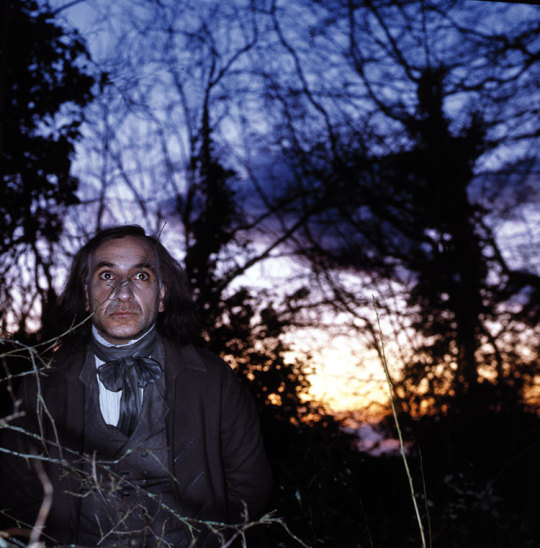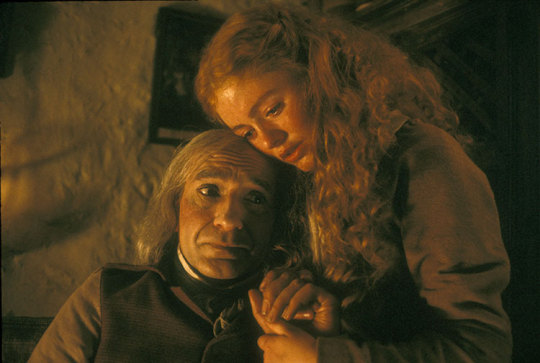#elizabeth hoyle
Explore tagged Tumblr posts
Text
"SILAS MARNER" (1985) Review

"SILAS MARNER" (1985) Review
I have seen a handful of television and movie adaptations of novels written by George Eliot. But the very first adaptation I ever saw was "SILAS MARNER", the 1985 version of Eliot's third novel published back in 1861. My recent viewing of the production led me to reassess it.
"SILAS MARNER" begins with an English weaver living with a small Calvinist congregation in Lantern Yard, a slum street in a Northern England city. His life falls apart when he is framed for stealing the church's funds, while watching over the congregation's ill deacon. Worse, his fiancee leaves him for his so-called best friend, the very man who may have framed him. Shattered and embittered, Silas leaves Lantern Yard and arrives at a rural village in the Midlands called Raveloe. Although he resumes his trade as a weaver, Silas' traumatized past leads him to achieve a reputation as a miser and a loner in the community.
Silas' move to Raveloe eventually leads him to cross paths with the community's leading citizens, the Cass family. The head of the latter is the elderly Squire Cass who has two sons - Godfrey and Dunstan. Godfrey, who is the squire's heir is secretly married to one Molly Farren, a lower-class woman and opium addict from another town, who has given birth to his young daughter. Godfrey is also engaged to a young middle-class woman named Nancy Lammeter. Dunstan is a dissolute wastrel who constantly loses money via excessive gambling. One night, a drunken Dunstan breaks into Silas' cottage, steals the gold coins that the latter has been hoarding and disappears. Through a series of events, Molly plots to expose her marriage to Godfrey and their child during the Cass family's New Year party, but dies in the snow before she can reach it. Silas, who is emotionally upset over the loss of his coins, finds both the dead Molly and the child. Although he informs the partygoers of Molly's death and the child, he assumes guardianship of the latter (renamed Hephzibah "Eppie"), much to the relief of Godfrey, who can now legally marry Nancy. All goes well until Godfrey and Nancy's failure to have children threaten Silas' newfound happiness as Eppie's father years later.
What can I say about "SILAS MARNER"? I can honestly say that it was not one of the best adaptations of a George Eliot novel. Then again, I do not consider the 1861 novel to be one of her best works. I realized that Eliot had set the story either around the end of the 18th century or around the beginning of the 19th century. It was her prerogative. But both the novel and the movie seemed to reek of Victorian melodrama that I found myself feeling that Eliot or any adaptation could have set the story around the time it was originally written and published - the mid 19th century. The story is, at best, a good old-fashioned Victorian melodrama. I would never consider it as particularly original in compare to the likes of "MIDDLEMARCH" or "DANIEL DERONDA".
"SILAS MARNER" tries its best to be profound on the same level as the other two Eliot stories I had mentioned. But I had a few problems with the narrative. What was the point behind Dunstan Cass' disappearance and theft? Yes, he stole Silas' hard earned money before he disappeared. I got the feeling that the stolen coins seemed to serve as a prelude to Silas' emotional attachment to Eppie. But why have Dunstan take it? How else did his disappearance serve the story . . . even after his dead remains were found close by, years later? In Eliot's novel, the discovery of Dunstan led brother Godfrey to form a guilty conscience over his own secret regarding young Eppie and confess to his wife. But in the movie, it was Godfrey and Nancy's inability to conceive a child that seemed to finally force the former to confess. Unless my memories have played me wrong. Frankly, Dunstan struck me as a wasted character. Anyone else could have stolen Silas' money.
I also noticed that Giles Foster, who had served as both screenwriter and director for this production, left out a few things from Eliot's novel. I have never expect a movie or television to be an accurate adaptation of its literary source. But I wish Foster had shown how Eppie's presence in Silas' life had allowed him to socially connect with Raveloe's villagers. Eliot did this by allowing her to lead him outside, beyond the confines of his cottage. The only person with whom Silas managed to connect was neighbor Dolly Winthrop, who visited his cottage to deliver him food or give advice on how to raise Eppie. I also noticed that in the movie, Silas had never apologized to another villager named Jem Rodney for his false accusation of theft. And Jem had never demanded it. How odd. I also wish that Foster could have included the segment in which Silas had revisited his former neighborhood, Lantern Yard. In the novel, Silas' visit revealed how the neighborhood had transformed into a site for a factory and its citizens scattered to other parts. Silas' visit to his old neighborhood served as a reminder of how his life had improved in Raveloe and it is a pity that audiences never saw this on their television screens.
Yes, I have a few quibbles regarding "SILAS MARNER". But if I must be really honest, I still managed to enjoy it very much. Eliot had written a very emotional and poignant tale in which a lonely and embittered man finds a new lease on life through his connection with a child. Thanks to George Eliot's pen and Giles Foster's typewriter, this story was perfectly set up by showing how Silas Marner's life fell into a social and emotional nadir, thanks to the betrayal of a "friend" and the easily manipulated emotions of his neighbors.
Once Silas moved to Raveloe, the television movie did an excellent, if not perfect, job of conveying how he re-connected with the world. It was simply not a case of Silas stumbling across a foundling and taking her in. Even though he had formed a minor friendship with Mrs. Winthrop, having Eppie in his life managed to strengthen their friendship considerably. The movie's narrative also took its time in utilizing how the Cass family dynamics played such an important role in Silas' life in Raveloe. After all, Godfrey' secret marriage to Molly Farren brought Eppie into his life. And Dunstan's theft of his funds led Silas to re-direct his attention from his missing coins to the lost Eppie. And both Godfrey and Nancy Cass proved to be a threat to Silas and Eppie's future relationship.
The production values for "SILAS MARNER" proved to be solid. But if I must be honest, I did not find any of it - the cinematography, production designs and costume designs - particularly memorable. The performances in the movie was another matter. "SILAS MARNER" featured solid performances from the likes of Rosemary Martin, Jim Broadbent (before he became famous), Nick Brimble, Frederick Treves, Donald Eccles, Rosemary Greenwood; and even Elizabeth Hoyle and Melinda White who were both charming as younger versions of Eppie Marner.
Angela Pleasence certainly gave a memorable performance as Eppie's drug addicted mother, Molly Farren. Patsy Kensit not only gave a charming performance as the adolescent Eppie, I thought she was excellent in one particular scene in which Eppie emotionally found herself torn between Silas and the Casses. Freddie Jones gave his usual competent performance as the emotional Squire Cass, father of both Godfrey and Dunstan. I was especially impressed by Jonathan Coy's portrayal of the dissolute Dunstan Cass. In fact, I was so impressed that it seemed a pity that his character was only seen in the movie's first half.
I initially found the portrayal of Nancy Lammeter Cass rather limited, thanks to Eliot's novel and Foster's screenplay. Fortunately, Nancy became more of a central character in the film's second half and Jenny Agutter did a skillful job in conveying Nancy's growing despair of her inability to have children and her desperation to adopt Eppie. I thought Patrick Ryecart gave one of the two best performances in "SILAS MARNER". He did an excellent job of conveying Godfrey Cass' moral ambiguity - his secrecy over his marriage to Molly Farren, the passive-aggressive manner in which he "took care" of Eppie through Silas and his willingness to use Eppie as a substitute for his and Nancy's failure to have children. Ryecart made it clear that Godfrey was basically a decent man . . . decent, but flawed. The other best performance in "SILAS MARNER" came from leading man Ben Kingsley, who portrayed the title character. Kingsley did a superb job of conveying Silas' emotional journey. And it was quite a journey - from the self-satisfied weaver who found himself shunned from one community, to the embittered man who stayed away from his new neighbors, to a man experiencing the joys and fears of fatherhood for the first time, and finally the loving man who had finally learned to re-connect with others.
Overall, "SILAS MARNER" is more than a solid adaptation of George Eliot's novel. I did not find its production designs particularly overwhelming. I did enjoy Eliot's narrative, along with Giles Foster's adaptation rather enjoyable . . . if not perfect. But I cannot deny that what really made this movie work for me were the first-rate performances from a cast led by the always talented Ben Kingsley. Victorian melodrama or not, I can honestly say that I have yet to grow weary of "SILAS MARNER".

#george eliot#silas marner#silas marner 1985#ben kingsley#angela pleasence#donald eccles#freddie jones#jenny agutter#jonathan coy#jim broadbent#nick brimble#patsy kensit#patrick ryecart#giles foster#elizabeth hoyle#melinda whiting#rosemary martin#robert putt#frederick treves#rosamund greenwood#period drama#period dramas#costume drama
0 notes
Text
Unexpected
The new addition to group therapy this morning confirms the rumors I overheard at breakfast. We have a new face at Bletchwood Residence, a face all of us have seen before from his movies or from one of his many ads. It’s a face framed by an angular jaw and prominent cheekbones, topped off with a crown of curly, dark hair. Right now, that face is surveying the rest of us like a god looking for…
View On WordPress
0 notes
Text















The Daily Front Row’s 10th Annual Fashion Media Awards was held at The Rainbow Room on Friday (8th September 2023) in New York City.
Grace Elizabeth (wearing Alaïa), Sarah Jessica Parker (wearing Oscar de la Renta), Emily Ratajkowski (wearing Dolce & Gabbana), Alexandra Daddario (wearing Dior), Dove Cameron (wearing Valentino), Jordyn Woods (wearing Saint Laurent), Winnie Harlow, Martha Hunt (wearing Cinq a Sept), Nadine Leopold, Melissa Roxburgh, Madeleine White, Marianne Fonseca, Kaylin Shepherd (wearing Azazie), Cass Dimicco and Matthew Leonard Hoyle, and Olivia Caputo.
#Daily Front Row's 10th Annual Fashion Media Awards#2023 Daily Front Row Fashion Media Awards#grace elizabeth#sarah jessica parker#emily ratajkowski#alexandra daddario#dove cameron#jordyn woods#winnie harlow#martha hunt#nadine leopold#melissa roxburgh#madeleine white#marianne fonseca#kaylin shepherd#cass dimicco#matthew leonard hoyle#olivia caputo#appearances#appearance#event#outfit#outfits#alaia#oscar de la renta#dolce & gabbana#dior#valentino#saint laurent#cinq a sept
5 notes
·
View notes
Text



This is the cope that will be worn by the Very Reverend Dr David Hoyle at the Coronation Service on 6 May 2023.
Made from crimson velvet and decorated with embroidered flowers and stars, the cope was made for the coronation of Charles II in 1661 and is the oldest in our collection.


The cope was also worn by Dean Alan Campbell Don when he took part in the coronation of The King's mother, Queen Elizabeth II, in the Abbey in 1953.
The cope is usually on display in the Abbey Galleries and you'll be able to see it there when we re-open for visiting next week.
NOTE:
Cope is a liturgical vestment worn by Roman Catholic and some Anglican clergy at non-eucharistic functions.
A full-length cloak formed from a semicircular piece of cloth, it is open at the front and is fastened at the breast by hooks or a brooch.
#Coronation Service#Coronation Service 2023#King Charles III#British Royal Family#Very Reverend Dr David Hoyle#Dean Alan Campbell Don#Abbey Galleries#Westminster Abbey#Queen Elizabeth II#cope
5 notes
·
View notes
Text
A national treasure is a cherished side character; they are never at the centre of events, and are, endearingly, never the holder of secular powers. They stand around the edges of a ruling class’s mental universe: observing, warning, guiding, admonishing – sometimes obliquely, sometimes not. They act as the conscience of a nation, or, rather, as the conscience of its rulers.
...
If we look at it this way, then the first ever British national treasure was Edmund Burke, famous for his Reflections. Burke was principled; Burke was conscientious; Burke was solemn; Burke was worthy; Burke never achieved a higher office than Paymaster of the Forces – a minor clerical job. Nevertheless, especially in the decade after his death in 1797, Burke could be cherished as the burning conscience of his society. Impossible to deal with as a man, but, nevertheless, part of the furniture. The immediate inheritor of this role was one of Burke’s contemporaries: William Wilberforce, the apostle of Victorianism, and the scourge of English popular customs like bear-baiting, bull-baiting, and boxing.
...
The suite of characteristics that makes up a national treasure lends itself to two archetypes, both forces for conservatism: the bureaucrat, and the light entertainer. So it has proven. Bruce Forsyth; David Frost; Stephen Fry; Betty Boothroyd; and latterly, Jackie Weaver, Lindsay Hoyle, and Sue Gray. All have been drawn from either of these two wells, and have led their lives accordingly.
The trouble is that Britain’s governing classes, especially after 1997, have begun to insist more and more strongly on these qualities: more rule-bound; more solemn; more strivingly modest. These characteristics, once endearing in their own way, have now started to ferment. Increasingly, the only individuals who would ever consent to play this role are either second-rate or suspect.
...
By the early 2020s, the standard British national treasure is an entertainer and informer, a bursar of charitable millions, a practitioner of old-fashioned mannerisms, who maintains a special relationship with the House of Windsor. This model – startlingly – remains the same basic one established by Jimmy Savile.
...
Meanwhile, the social importance of these people is evermore emphasised by England’s ruling classes. One refrain about Elizabeth II was that she, in her person, ‘held together’ 21st Century Britain: the same has been said of David Attenborough and Captain Tom Moore. This kind of hysteria has no foreign analogue; in the United States, Tom Hanks and Dwayne “The Rock” Johnson are not assigned such a role in the body politic.
Louder also is the insistence that we like these people. My first visceral experience of this was when I was informed in a series of adverts that I loved Phillip Schofield, a television presenter of little distinction. As we have seen, these people are not for our consumption. It is therefore of little surprise that they seldom inspire any real popular love. Stephen Fry and Sandi Toksvig are not liked, only obeyed. There is a garrison quality to these national treasures. Beyond their core constituency of public sector employees, popular opinion on these people ranges from sullen indifference to outright hostility.
2 notes
·
View notes
Text
Follow Me
Author: Elizabeth Hoyle He’d kept his charging cord in all night so his hands wouldn’t shake as he went about town. Yet they shook. His audio sensors were primed for any and all noises within a two hundred yard perimeter, no matter where he had walked throughout the city. It must have taken more out of him than he expected. There was only one more location to visit. He shifted the folder that…
0 notes
Text

I love the beautiful embroidery on David Hoyle's cope:

This is a truly historic garment! According to Westminster Abbey, it was made for the coronation of Charles II in 1661. It was also worn by the then-dean of Westminster, Alan Campbell Don, for the coronation of Elizabeth II.
1 note
·
View note
Text










Silas Marner: The Weaver of Raveloe - BBC / A&E - December 30, 1985
Drama
Running Time: 92 minutes
Stars:
Ben Kingsley as Silas Marner
Jenny Agutter as Nancy Lammeter
Patrick Ryecart as Godfrey Cass
Rosemary Martin as Dolly Winthrop
Jonathan Coy as Dunstan Cass
Angela Pleasence as Molly
Freddie Jones as Squire Cass
Patsy Kensit as Eppie
Elizabeth Hoyle as Baby Eppie
Melinda Whiting as Little Eppie
Robert Putt as Ben Winthrop
Jim Broadbent as Jem Rodney
Tony Caunter as Mr. Snell
Michael Bilton as Mr. Macey
Nick Brimble as Bob Dowlas
Frederick Treves as Mr. Lammeter
#Silas Marner#TV#BBC#A&E#Drama#1985#1980's#Ben Kingsley#Jenny Agutter#Patrick Ryecart#Rosemary Martin#Jonathan Coy#Angela Pleasence#Freddie Jones#Patsy Kensit
1 note
·
View note
Text
King Charles and Queen Camilla are attending their first Commonwealth Day service as the reigning couple.
The King, 74, and Queen Consort, 75, joined members of the royal family at Westminster Abbey on Monday for the annual event honoring the 56 countries and nations that make up the Commonwealth. Other members of the royal family in attendance included Prince William and Kate Middleton, Prince Edward and Sophie (the new Duke and Duchess of Edinburgh), and Princess Anne and Vice Admiral Sir Tim Laurence.
During the event, King Charles gave his Commonwealth Day address from the Great Pulpit at Westminster Abbey, in which he remembered his mother, Queen Elizabeth.
"Commonwealth Day was an occasion of particular pride for my beloved mother, the late Queen — a treasured opportunity to celebrate our Commonwealth family, to whose service she dedicated her long and remarkable life," he said. "In succeeding Her Majesty as Head of the Commonwealth, I draw great strength from her example, together with all that I have learned from the extraordinary people I have met throughout the Commonwealth, over so many years."
The King added, "The Commonwealth has been a constant in my own life, and yet its diversity continues to amaze and inspire me as a force for good in the world that demands our highest ambition; its sheer scale challenges us to unite and be bold."
He also spoke at the service last year, standing in for Queen Elizabeth, who missed the event. Queen Elizabeth's 2022 Commonwealth Day address, which she wrote from Windsor Castle, renewed her pledge to continue the promise she made 75 years ago that she will be forever "devoted" to her public work. "In this year of my Platinum Jubilee, it has given me pleasure to renew the promise I made in 1947 that my life will always be devoted to service," she stated in her message.
Queen Camilla honored Queen Elizabeth with her outfit, sporting a sapphire and diamond brooch that belonged to the monarch. The accessory adorned her blue wool crepe dress and coat by Fiona Clare, paired with a feathered beret by Philip Treacy (which she held with one hand to avoid a wardrobe mishap in the wind!).
If her outfit looks familiar, there's a good reason: Camilla sported the same hat and coat for the first state visit of King Charles' reign in November, when they welcomed South African President Cyril Ramaphosa to the U.K.
The Commonwealth Day theme for 2023 is "Forging a Sustainable and Peaceful Common Future." On King Charles and Queen Camilla's arrival at Westminster Abbey, they were met by the Dean of Westminster before they greeted members of the Ngāti Rānana London Māori Club. King Charles also met some of them with the hongi, a traditional Māori greeting where two people press their noses and foreheads together.
The service began with a procession of flags from Commonwealth member states, including a specially designed Commonwealth Flag for Peace. In his welcome, the Dean of Westminster, the Very Reverend Dr. David Hoyle, said that the congregation was together "in this house of prayer and place of a coronation in the year of coronation" to celebrate as a Commonwealth of Nations. Leading a prayer for peace, he added, "We will pray too for our King as we look to the day when we will gather here again in loyalty and affection as people of faith, hope, and compassion; we shall pray for the peoples of Turkey, Syria, and Ukraine, and all for whom the last year has brought great suffering and loss."
The annual event featured musical performances from saxophonist Yolanda Brown, West End stars Roshani Abbey and Nuwan Hugh Perera, and the all-female Amalgamation Choir from Cyprus. Marking Rwanda's role as the current Commonwealth Chair-in-Office, the Rwandan National Ballet, Urukerereza, also performed.
Throughout Queen Elizabeth's 70-year reign, the Commonwealth grew from just seven nations to 54 members. Gabon and Togo joined in 2022, bringing the total number of nations to 56. "In collaboration towards shared economic, environmental, social, and democratic goals, the Service seeks to highlight a vast community that spans every geographical region, religion, and culture, embracing the diversity of its population of 2.5 billion people, of which over 60 percent are under 30 years old," the palace said in a statement.
The Commonwealth Day Service marked the first public outing for Queen Camilla after she had to cancel her planned visit to Newmarket for a pair of royal engagements on Thursday due to inclement weather.
0 notes
Photo

Don’t you know i wanna be your friend?
Smooth Talk, Joyce Chopra (1985)
#Joyce Chopra#Tom Cole#Treat Williams#Laura Dern#Mary Kay Place#Margaret Welsh#Sara Inglis#Levon Helm#Elizabeth Berridge#Geoff Hoyle#William Ragsdale#David Berridge#James Glennon#James Taylor#Russ Kunkel#George Massenburg#Bill Payne#Patrick Dodd#1985#woman director
73 notes
·
View notes
Text
Day 6-Personal headcanon (about each of the garde & co.) :)
One- I feel like One loved to paint her nails and try different intricate designs each time she did her nails!
Two- Maggie L O V E S hot chocolate especially when its so hot it literally scalds your tastebuds off ;D
Hannu- Hannu absolutely adores dogs and he hoped to own a thai ridgeback one day
John- John is extremely in love with bon jovis music and he blasts it at the highest volume all the time and it irritates the others so much 💀
Five- Five has a secret love for writing and hides all of his writing because if someone found it he would be mortified
Six- Six can sing really well and never sings infront of anyone. Only marina has heard her sing and keeps begging Six to sing Brand New City and liquid smooth by Mitski (she keeps refusing💀).
Marina- Marina loves Mitski’s music and she loves to wear the huge baggy hoodie she stole from six as it’s so comfortable ;D.
Eight- Eight loves Christmas and everything about winter. He absolutely L O V E S sitting infront of a fire after a long ,cold day:).
Nine- Nine loves spicy food. Everytime he’s out in a restaurant he orders the most spicy thing he can see. He also has a fondness towards cats especially british shorthairs.
Ella- Ella has a passion for cooking and she adores trying new recipes no matter how difficult they seem. She always asks the others to try her food as seeing their reactions make her feel great;D.
Sam- Sam loves art especially paintings of landscapes. He wishes he could paint like marina and is content with watching her painting process as it always makes him appreciate art even more.
Sarah- Sarah takes pictures of the others as much as she can. She wants to make as many memories with the others as she can and loves spending time with them all as she feels most comfortable in the presence of many people:).
Adam- Adam loves green day’s music and his favorite song is basket case. He always wanted to see them in concert but never got the chance so he buys tons of merch instead.
Daniela- Daniela loves astronomy and could talk about it ALL day long. She always talks about different planets to the garde and asks them stupid questions like “would you ever go to mercury to like see the sun even closer?” Whenever they throw her concerned looks she asks them wtf is wrong 💀
#lorien legacies#loric garde#lorien#i am number 4#i am number four#number six#six#garde#october 2022#13yearsoflorien#maren elizabeth#lorictober#marina#nine#stanley#hannu#number three#maggie hoyle#number two#number one#adamus#adamus sutekh#adam#sam goode#sarah hart#john smith#number four#number five#number seven#number eight
21 notes
·
View notes
Conversation
Lorien Legacies Characters as Things My Family and I Have Said (Part Three)
John: Am I cute
Six: Whatever makes you happy
--
Marina: Where’s my perfume?
Eight: I drank it
--
Nine: *squeezes bread* I just really felt like doing that
Five: I feel like doing that to you
--
Eight: Use your bread you fucking heathen
--
Five, tucking Maggie and Ella into bed: Night night c*nts
Maggie and Ella, in unison: REEEE
--
John: *attempts to do something but fails*
Nine: Bitch thought
John: Shut up
Six: Bitch thought
Five: Bitch thought
One: Bitch thought
Eight: Bitch thought
Adam: Bitch thought
John: I hate you guys so fucking much
--
Eight: Is eating this much cheese even healthy???
--
John: Raise your hand if you love dogs
Adam: I would but I’m eating goldfish
--
Five, on an Omegle video chat with a knocked-out Sam and Ella: They're dead
Nine, on the other end of the call: Tell them to get up
--
Six: Men are dumb. Fuck men. You know, what? To all the ladies in the chat, here's some advice.
Six: Become a lesbian
Six: Adopt a cat
Six: Plant a garden
Six: Live in a forest
Six: Destroy the patriarchy
Six: Travel the world
Six: Fuck shit up
Six: And do it with a smile and a piña colada *bites chip*
--
Marina: I was gonna wear a cute pink flower crown with my outfit but then I thought fuck that, I'm going low-key cottagecore, not Ohioan frolicker or Idahoan horse girl
--
Adam: Dude, are you high?
Sam: What? No
Sam, suddenly remembering he rode passenger while Nile smoked weed on their way home and has gotten high off second-hand smoking weed before: OH SHI-
--
Five: Why am I even up at four in the morning with chips and Mountain Dew???
Marina: I mean, it could be from insomnia rooting from your depressio-
Five: Depression? BITCH PLEASE that shit is so 2019
--
Adam's teacher: I know it's Monday, but if it's any comfort, today is the first day of the last week of April!
Adam: What the FUCK did you just say to me-
--
Eight, mimicking an old man: gEt OfF mY lAwN
Sam: *puts face in bowl and laughs*
--
Nine, knocking on the door: Let me innnnn
John, sitting against the door so Nine doesn't come in: No, I'm still mad at you
Nine: Ok ok I'm sorry, I'll pay you fifty dollars
--
Five, trying to be compassionate with Nine: Remember when we used to match hairstyles, you fuck?
--
Literally anyone: *laughs*
Eight: Giggles
--
Hannu: No sad, just ball
--
Six: fight me fight me fight me fight me fight me fight me square up square up square up sqUARE UP SQUARE U-
--
One: Can I use your headphones?
Adam: Sorry, I'm using the-
One: Shut up you dumb fuck
--
Eight, talking to himself in the mirror: Oh my god look at you in your big, baggy flannel you look sO CUTE you're adorable don't let anyone tell you differently, including you you dumb fucking insecure little bitch
--
Daniela: What would happen if a woman took penis enlargement pills?
Adam: Hey no offense but what the fuck is wrong with you?
--
John: What even goes on in your mind?
Nine: Tarot cards, money, Cotton Eye Joe on loop, applesauce, lighting a house on fire, jumping out a second-story house to see if my ankle is durable or not...
John:...
Nine: But mostly Cotton Eye Joe on loop
--
Five: Some people identify as she/her. Some people identify as he/him. Some people identify as they/them. I identifty as a fucking disappointment.
--
Marina: Hey, can I ask you a question?
Eight, naked in a bubble-filled bathtub with lit candles, a wine glass full of apple juice, and IceJJFish playing: Do I look like someone with the fucking time?
--
John: Hey, are you gay?
Adam, sitting on the ground blasting Ariana Grande with an iced almond milk latte and wearing a baggy flannel shirt: BITCH-
--
Six: *opens her online-shopping package*
Marina: Uh, those are going to make you look a little emo, aren't they?
Six, putting on her thick chain choker and leather gloves: that's the poINT-
--
Sam: *dances like a crab to the Crab Rave* Crabby Rave make pain go away
--
One: 'oH i DoNt HaVe PrOnOuNs'- what the fuck are you then, a toaster?
--
Random celebrity: Wow, fangirls are so sweet and dedicated, they really should get paid for all the promotions and hard work they do!
Six: Ok pay me then
--
Maggie, crying: All I wanted was some fucking chicky nuggies
--
Sam, walking up to Nine in public: Hey bestie-
Nine: I don't know you
Sam: Bitch-
--
Ella: I'm gonna send a celebrity a meme everyday until they reply to me
Marina: Why?
Ella: Why the fuck not?
--
Five: Yeah, I'm depressed *laughs*
John: Why'd you laugh?
Five: It's a coping mechanism
--
Maggie: I don't want a boyfriend or a girlfriend or a partner I wants the three D's
Sarah, horrified: The WHAT
Maggie: Dogs, donuts, and diamonds
--
Hannu: So there's this philosophy theory-
One: I will fucking drown you
--
Six: If you are male and you have a flat ass, don't speak to me. I need guy friends who match my level of THICKNESS
--
One: Oh my god she's so cute
Adam: She has a girlfriend
One: Sharing is caring
--
Five: If ONE MORE BITCHASS WHORE comments on my clothes and shits about how feminine I dress I swear I will be gOING TO JAIL
Five: JUST SAY YOU ARE JEALOUS YOU CAN'T WORK BOTH AND LEAVE BITCH
--
Nine: So I have this problem where I hate myself but I still think I'm better than everyone else
John:...
Nine: Like I'm trash but I'm QUALITY trash, I'm trash from the garbage bags of Louis Vuitton, I'm recyclable, reusable trash, I'm the trash no one wants to throw away
John: Um...
Nine: If Gucci made a limited-edition, 24-karat gold garbage bag, I'd be that garbage bag
--
Maggie, holding a nerf gun to Adam's head: Gimme all your fucking money
--
Sam: I don't know, I've just been feeling a little down lately
Six: No
Sam: What?
Six: That's not allowed
Sam: Wha-
Six: *smacks Sam in the face with a pillow*
--
Maggie: BESTIE. YOU ARE A BAD BITCH. DON'T LET ANYONE TELL YOU DIFFERENTLY. WORK IT QUEEN
The pigeon on the sidewalk:
#lorien legacies#garde#mogadorians#cepans#i am number four#back at it again with the lorien legacies content#i love this series#my family is chaotic#one#maggie hoyle#two#hannu#three#four#john smith#five#cody#six#maren elizabeth#seven#marina#eight#naveen#nine#stanley worthington#ten#ella#adamus sutekh#adam sutekh#sarah hart
76 notes
·
View notes
Text
A New Adventure
“I’m afraid I might be turning into a tree.” The assistant chiropractor looks away from the computer he’s typing his notes into. He half-smiles. “I’m nearly done, then we’ll start making you feel like a human again, Kit.” He resumes his typing and I wonder how he’ll react once he feels how wooden my back has become. I bite my tongue as punishment for saying my fears out loud. I still don’t know…
View On WordPress
0 notes
Text










Loric Garde + life lessons
#lorien legacies#loric garde#number one#number two#number three#number four#number five#number six#number seven#number eight#number nine#maggie hoyle#hannu#john smith#cody#maren elizabeth#marina#naveen#stanley worthington#ella#my art
45 notes
·
View notes
Text




December 2022 Amidst final preparations for the #TogetherAtChristmas carol service at Westminster Abbey last week, The Princess of Wales planted a tree for the #queensgreencanopy in honour of Her late Majesty Queen Elizabeth II❤️ Alongside the Dean of Westminster, the Very Reverend Dr David Hoyle, and members of the Abbey’s gardening team, Her Royal Highness planted a wild cherry tree in the Dean’s Yard, which joins over a million trees planted across the UK as part of the #queensgreencanopy 🌳 🇬🇧 Westminster Abbey has a unique bond with the Royal Family as the setting of special occasions, past & present⛪️ Queen Elizabeth II’s coronation in 1953 👑 The Duke & Duchess of Cambridge's Royal wedding in 2011 💒 The upcoming coronation of our Patron, His Majesty The King💚 — The Queen's Green Canopy
208 notes
·
View notes
Text
“It’s impossible to be in love with all the six queens’
The Six queens in question:
Megan Gilbert, Ashleigh Weir, Holly Musgrave, Oliver Wickham, Annabel Marlow, Shimali De Silva, Renee Lamb, Christina Modestou, Natalie Paris, Genesis Lynea, Aimie Atkinson, Izuka Hoyle, Jaye’J Richards-Noel, Millie O’Connell, Alexia McIntosh, Maiya Quansah-Breed, Grace Mouat, Vicki Manser, Courtney Stapleton, Adrianna Hicks, Andrea Macaseat, Abby Mueller, Brittney Mack, Samantha Pauly, Anna Uzele, Mallory Maedke, Nicole Kyoung-Mi Lambert, Courtney Mack, Shantel Cribbs, Courtney Bowman, Sophie Isaacs, Danielle Steers, Zara Macintosh, Cherelle Jay, Hana Stewart, Collette Guitart, Candace Furbert, Hazel Karooma-Brooker, Caitlin Tipping, Sophie Golden, Alicia Corrales-Connor, Viquichele Cross, Bryony Duncan, Natalie Pilkington, Lori McLare, Amy Bridges, Lauren Drew, Maddison Bulleyment, Lauren Byrne, Shekinah McFarlane, Jodie Steele, Athena Collins, Cassandra Lee, Jennifer Caldwell, Harriet Watson, Jasmine Shen, Kelly Sweeney, Jessica Niles, Georgia Carr, Amelia Walker, Liv Alexander, Elizabeth Walker, Maddison Firth, Laura Blair, Chloe Zuel, Kala Gare, Loren Hunter, Kiana Daniele, Courtney Monsma, Vidya Makan, Ella Burns, Karis Oka, Shannen Alyce-Quan, Jade Marvin, Lucy Aiston, Gabriella Stylianou-Burns, Scarlet Gabriel, Rebecca Wickes, Megan Leung, Sophie Rose Middleton, Abbi Hodgson, Kara Ami Mcraenor, Emily Harrigan, Gabrielle Smith, Melissa Ford, Kaylah Attard, Fia Houston-Hamilton, Rhiannon Bacchus, Rhiannon Doyle, Carly Mercedes Dyer, Elena Gyasi, Keirsten Hodgens, Artemis Chrisoulakis, Ellie Sharpe, Sadie Hurst, Melinda Porto, L’Oreal Roache, Wesley Carpenter, Maya Christian, Brianna Mooney, Meghan Dawson, Marilyn Caserta, Ashlee Waldbauer, Adrianna Glover, Alize Ke’Aloha Cruz, Kristina Walz, Amy Di Bartolomeo, Amanda Lindgren, Claudia Kariuki, Dionne Ward-Anderson, Tsemaye Bob-Egbe, Meesha Turner, Paisley Billings, Danielle Rose, Roxanne Couch, Esme Rothero, Rachel Rawlinson, Lauren Irving, Danielle Mendoza, Shelby Griswold, Kennedy Carstens, Abigail Sparrow, Jarynn Whitney, Madeline Fansler, Channing Weir, Princess Victomé, Sunayna Smith, Chloë Hart, Casey Al-Shaqsy, Aiesha Pease, Jaina Brock-Patel, Alana Robinson, Grace Melville, Leesa Tulley, Harriet Caplan-Dean, Khaila Wilcoxon, Storm Lever, Jasmine Forsberg, Olivia Donalson, Didi Romero, Gabriela Carrillo, Cassie Silva, Kelly Denice Taylor, Erin Ramirez, Kelsee Kimmel, Phoenix Mendoza, Chelsea Dawson, Chiara Assetta, Cristina D’Agostino, Joy Woods, Bre Jackson, Keri Rene Fuller, Brennyn Lark, Ayla Ciccone-Burton, Holli’ Conway, Brianna Javis, Gabbi Mack, Casey Esbin, Ellie Wyman, Sasha Renae Brown, Nicole Lamb, Aja Simone Baitey, Willow Dougherty, Kayla McSorely, Emily Rose Lyons, Chelsea Wargo, Hannah Taylor, Jessie Bodner, Jasmine Hackett, Janice Rijssel, Lucia Valentino, Elena Breschi, Meg Dixon-Brasil, Sarah McFarlane, Reca Oakley, Gerianne Perez, Zan Berube, Amina Faye, Terica Marie, Aline Mayagoitia, Sydney Parra, Jana Larell Glover, Taylor Pearlstein, Aryn Bohannon, Cecilia Snow, Rhianne Louise McCaulsky, Baylie Carson, Koko Basigara, Monique Ashe Palmer, Leah Vassell, Hailee Kaleem Wright, Leandra Ellis Gaston, Bella Coppola, Nasia Thomas, Zoe Jensen, Taylor Iman Jones, Aubrey Matalon, Kristina Leopold, Rae Davenport, Gianna Grosso, Kathryn Kilger, Bethany McDonald, Jillian Worthing, Haley Izurieta, Jasmine Smith, Lois Ellise Reeves, Alyssa Giannetti, Eden Holmes, Jaelle Laguerre, Kate Zulauf, Lee ARumSoul, Son Seungyeon Kim Ji Woo, Sophiya Pae, Park Hye-na, Park Ga-Ram, Kim Ji Sun, Choi Hyun-sun, Kim Ryeo Won, Heo Sol-ji, Yoo Ju-hye, Hong Ji Hee, Nicole Louise Lewis, Laura Dawn Pyatt, Erin Caldwell, Kenedy Small, Lou Henry, Aoife Haakenson, Ellie Jane Grant, Izi Maxwell, Tamara Morgan, Shakira Simpson, Fiorella Bamba, Lucinda Wilson, Caitlyn De Kuyper, Amanda Lee, Gabriella Boumford, Audrey Fisher, Brooke Aneece, Jaz Robinson, Julia Pulo, Maggie Lacasse, Krystal Hernández, Elysia Cruz, Lauren Mariasoosay, Julia McLellan, Darcy Stewart, Hailey Lewis
#six musical#six the musical#six#six alternates#six uk tour#six west end#six australia#six broadway#six cruise#jane takes
57 notes
·
View notes